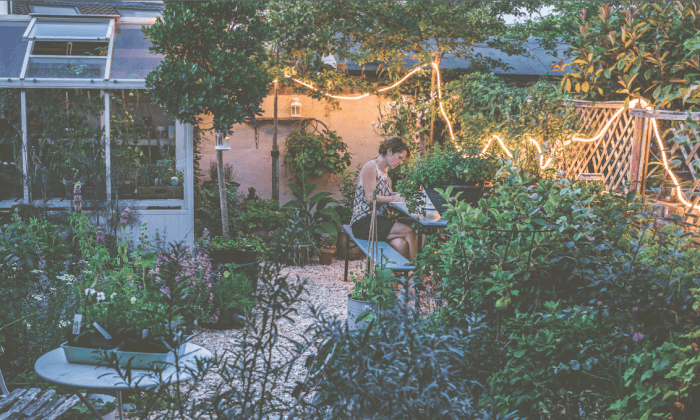I like to roll with the idea that the best things come in small packages. However, small can also be frustrating if you’ve got the gardening bug and want to be able to grow an array of blooms. Thankfully, there are some tricks you can use to be creative and make the most of your space.
The key thing about a small garden is that it won’t have the breadth of aspect for you to grow a huge range of plants. It’ll either be shady with a small corner that’s sunny, or vice versa. For a roof garden, you’ll need to consider plants that aren’t bothered by exposed sites. And if you have a courtyard garden, shade-loving plants will be your go-to group. Once you know what type of environment you have, you can narrow down the field of choice, which is a good thing when space is restricted.
Think carefully about your boundaries. One option is to “borrow” your neighbor’s landscape. I have two juneberry trees in my backyard and my next-door neighbors on the right-hand side have one too, so in a sense we both have three trees. We bought and planted them together to try to mask a house at the rear of our plots and to create a sense of unity along the back wall. It’s a very effective technique and I really enjoyed having a chat with my neighbors over a glass of wine to pick out which trees to go for. The other trick with boundary walls and fences is to use them to grow plants vertically. I like to use climbers to grow up walls and create a lovely green effect. Varying the heights and sizes of containers—I’m thinking medium and large containers here—also helps create an interesting rhythm along a wall or fence.
Remember to restrict your color palette and choice of plants to avoid the feeling of chaos or confusion that comes with an eclectic collection—unless, of course, that’s your thing, in which case rules are made to be broken. However, if you decide on a limited color scheme (yellow, orange and red, for example), you mustn’t be despondent when you have to pass over gorgeous blooms in other colors. Careful consideration and cohesive thinking really do work wonders. More often than not, I tend to flout this rule, believing that it is more important to grow what you love rather than what you should have. This year, I’m utterly delighted with a color palette of white, blue and purple with the occasional pop of orange. The whole effect has tied the garden together, unlike the haphazard collection of colors seen in previous years.
Restricting your color palette also applies to textures and shapes. Repeating plants with similar attributes is an easy way to create rhythm in a border or series of containers that helps the eye take in and “read” the entire plot.
Planting a small tree—or as many as you dare—in a tiny plot is a surprisingly counterintuitive way to make a space feel bigger. Strangely, the scale helps play with the sense of space, expanding it vertically and horizontally, encouraging your eye to look up and out across the garden. The standard, or lollipop, tree keeps a larger specimen contained. However, multi-stemmed trees can be used just as effectively, if not quite as liberally. In my opinion, trees are an overlooked asset of the small city garden, encouraging a variety of wildlife to take up residence and add to the ecosystem.
Finally, one more trick is to work with objects of different sizes to manipulate the sense of perspective in a tiny space. The idea is simple: place the largest containers and features closest to the house and then gradually reduce the scale of garden objects as you move further away from the house to accentuate the sense of perspective.
Excerpted with permission from “Grow Your Own Botanicals: Deliciously Productive Plants for Homemade Drinks, Remedies and Skincare” by Cinead McTernan (Kyle Books).
Friends Read Free